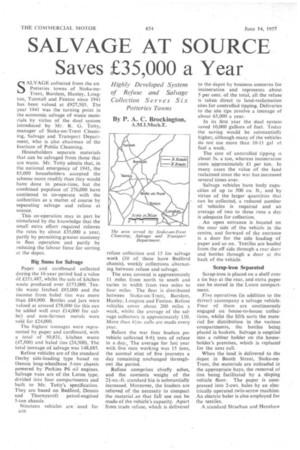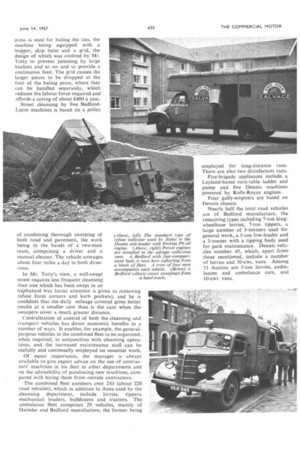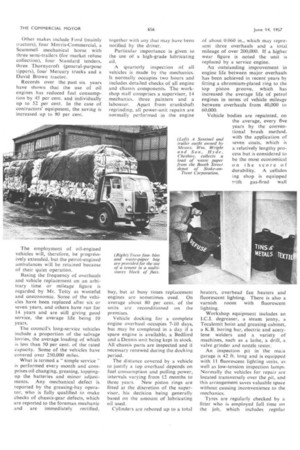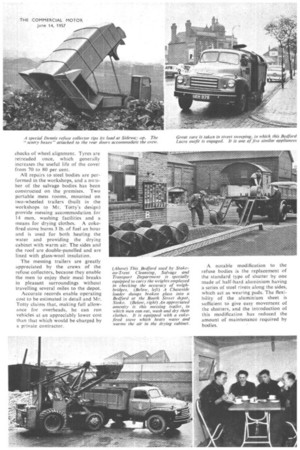SALVAGE AT SOURCE Saves £35,000 a Year
Page 66

Page 67

Page 68

Page 69

If you've noticed an error in this article please click here to report it so we can fix it.
Highly Developed System of Refuse and Salvage Collection Serves Six Potteries Towns By P. A. C. Brockington,
A.M.I.Mech.E. SALVAGE collected from the six Potteries towns of Stoke-onTrent, Burslem, Hanley, Langton, Tunstall and Fenton since 1941 has been valued at £927,505. The year 1941 was the turning point in the economic salvage of waste materials by virtue of the dual system introduced by Mr. R. G. Tatty, manager of Stoke-on-Trent Cleansing, Salvage and Transport Department, who is also chairman of the Institute of Public Cleansing.
Householders separate materials that can be salvaged from those that are waste. Mr. Totty admits that, in the national emergency of 1941, the 85,000 householders accepted the scheme more readily than they would have clone in peace-time, but the combined populace of 276,000 have continued to co-operate with the authorities as a matter of course by separating salvage and refuse at source.
This co-operation may in part be stimulated by the knowledge that the small extra effort required relieves the rates by about £35,000 a year, partly by permitting greater economy in fleet operation and partly by reducing the labour force for sorting at the depot.
Big Sums for Salvage
Paper and cardboard collected during the 16-year period had a value of £351,487, whilst the sale of kitchen waste produced over £173,000. Textile waste fetched £93,000 and the income from baled tins was more than £84,000. Bottles and jars were valued at around £78,000 (to this can be added well over £14,000 for cullet) and non-ferrous metals were • sold for £24,000.
The highest tonnages were represented by paper and cardboard, with a total of 50,831, kitchen waste (47,500) and baled tins (24,500). The total tonnage of salvage was 148,685.
Refuse vehicles are of the standard Derby side-loading type based on Dennis long-wheelbase 5-ton chassis powered by Perkins P6 oil engines. Salvage vans are of the Luton type, divided into four compartments and built to Mr. Totty's specification. They are based on Bedford, Dennis and Thornycroft petrol-engined 5-ton chassis.
Nineteen vehicles are:used for D16 refuse collection and 15 for salvage work (10 of these have Bedford chassis), weekly collections alternating between refuse and salvage.
The area covered is approximately Il miles from north to south and varies in width from two miles to four miles. The fleet is distributed between Stoke-on-Trent, Burslem, Hanley, Langton and Fenton. Refuse vehicles cover about 200 miles a week, whilst the average of the salvage collectors is approximately 150. More than 41m. calls are made every year.
Before the war four loaders per vehicle collected 9-91 tons of refuse in a day., The average for last year with five men working was 15 tons, the normal stint of five journeys a day remaining unchanged throughout the period.
Refuse comprises chiefly ashes, and the contents weight of the 2i-cu.-ft. standard bin is substantially increased. Moreover, the loaders are relieved of the necessity to compact the material so that full use can be made of the vehicle's capacity. Apart from trade refuse, which is delivered to the depot by business concerns for incineration and represents about 5 per cent, of the total, all the refuse is taken direct to land-reclamation sites for controlled tipping. Deliveries to the site tips involve a tonnage of about 65,000 a year.
In its first year the dual system saved 10,000 gallons of fuel. Today the saving would be substantially higher, although many of the vehicles do not use more than 10-11 gal of fuel a week.
The cost of controlled tipping is about 5s. a ton, whereas incineration costs approximately £1 per ton. In many cases the value of the land reclaimed since the war has increased several times over.
Salvage vehicles have body capacities of up to 500 Cuft., and by virtue of the larger quantities that can be collected, a reduced number of vehicles is required and an average of two to three runs a day is adequate for collection.
• An open entrance is located on the near side of the vehicle in the centre, and forward of the entrance is a door for the side loading of paper and so on. Textiles are loaded from the off side through a rear door
• and bottles through a door at the back of the vehicle.
Scrap-iron Separated
Scrap-iron is placed on a shelf over a tin bay at the rear, and extra paper can be stored in the Luton compartment.
Five operatives (in addition to the driver) accompany a salvage vehicle. Four of them are continuously engaged on house-to-house collections, whilst the fifth sorts the material for distribution in the various compartments, the bottles being placed in baskets. Salvage is emptied into a rubber holder on the householder's premises, which is replaced for the next call.
When the load is delivered to the depot in Booth Street, Stoke-onTrent, the materials are unloaded in the appropriate bays, the removal of tins being facilitated by a sloping vehicle floor. The paper is compressed into 2-cwt. bales by an electrically operated twin-screw machine. An electric baler is also employed for the textiles.
A standard Strachan and Henshaw press is used for baling the tins, the machine being equipped with a hopper, skip hoist and a grid, the design of which was evolved by Mr. Totty to prevent jamming by large buckets and so on and to provide a continuous feed. The grid causes the larger pieces to be dropped at the foot of the baling press, where they can be handled separately, which reduces the labour force required and affords a saving of about £400 a year.
Street cleansing by five BedfordLacre machines is based on a policy of combining thorough sweeping of both road and pavement, the work being in the hands of a two-man team, comprising a driver and a manual cleaner. The vehicle averages about four miles a day in both directions.
In Mr. Totty's view, a well-swept street requires less frequent cleansing than one which has been swept in an haphazard way (strict attention is given to removing refuse from corners and kerb pockets), and he is confident that the daily mileage covered gives better results at a smaller cost than is the case when the sweepers cover a much greater distance.
Centralization of control of both the cleansing and transport vehicles has direct economic benefits iii a number of ways. It enables, for example, the generalpurpose vehicles in the combined fleet to be organized, when required, in conjunction with cleansing operations, and the increased maintenance staff can be usefully and continually employed on essential work.
Of equal importance, the manager is always available to give expert advice on the use of contractors' machines in his fleet to other departments and on the advisability of purchasing new machines, compared with hiring them from outside contractors.
The combined fleet numbers over 243 (about 220 road vehicles), which in addition to those used by the cleansing department, include lorries, tippers, mechanical loaders, bulldozers and tractors. The ambulance fleet comprises 29 vehicles, mainly of Daimler and Bedford manufacture, the former being employed for long-distance runs. There are also two disinfectant vans.
Fire-brigade appliances include a Leyland-based turn-table ladder and pump and five Dennis machines powered by Rolls-Royce engines.
Four gully-emptiers are based on Dennis chassis.
Nearly half the total road vehicles are of Bedford manufacture, the remaining types including 7-ton longwheelbase lorries, 7-ton tippers, a large number of 5-tonners used for general work, a 5-ton low-loader and a 3-tonner with a lipping body used for park maintenance. Dennis vehicles number 45, which, apart from those mentioned, include a number of lorries and 30-cwt. vans. Among 33 Austins are 5-ton lorries, ambulances and ambulance cars, and 10-cwt. vans. Other makes include Ford (mainly tractors), four Morris-Commercial, a Scammell mechanical horse with three semi-trailers (for market refuse collection), four Standard tenders, three Thornycroft (general-purpose tippers), four Mercury trucks and a David Brown tractor.
Records over the past six years have shown that the use of oil engines has reduced fuel consumption by 45 per cent. and individually up to 52 per cent. In the case of contractors' equipment, the saving is increased up to 80 per cent.
The employment of oil-enginec.1 vehicles will, therefore, be progressively extended, but the petrol-engined ambulances will be retained because of their quiet operation.
Basing the frequency of overhauls and vehicle replacement on an arbitrary time or mileage figure is regarded by Mr. Totty as wasteful and uneconomic. Some of the vehicles have been replaced after six or seven years, and others have run for 14 years and are still giving good service, the average life being 10 years.
The council's long-service vehicles include a proportion of the salvage lorries, the average loading of which is less than 50 per cent. of the rated capacity. Some of the vehicles have covered over 250,000 miles.
What is termed a "simple service " is performed every month and comprises oil changing, greasing, toppingup the batteries and minor adjustments. Any mechanical defect is reported by the greasing-bay operator, who is fully qualified to make checks of chassis-gear defects, which are reported to the foreman mechanic and are immediately rectified, together with any that may have been notified by the driver.
Particular importance is given to the use of a high-grade lubricating oil.
A quarterly inspection of all vehicles is made by the mechanics. It normally occupies two hours and includes detailed checks of all engine and chassis components. The workshop staff comprises a supervisor, 14 mechanics, three painters and a labourer. Apart from crankshaft regrinding, all power-unit repairs are normally performed in the engine bay, but at busy times replacement engines are sometimes used. On average about 80 per cent. of the units are reconditioned on the premises.
Vehicle docking for a complete engine overhaul occupies 7-10 days, but may be completed in a day if a spare engine is available, a Bedford and a Dennis unit being kept in stock. All chassis parts are inspected and it necessary renewed during the docking period.
The distance covered by a vehicle to justify a top overhaul depends on fuel consumption and pulling power, intervals varying from 12 months to three years. New piston rings are fitted at the discretion of the supervisor, his decision being generally based on the amount of lubricating oil used.
Cylinders are rebored up to a total of about 0.060 in., which may represent three overhauls and a total mileage of over 200,000. If a higher wear figure is noted the unit is replaced by a service engine.
An outstanding improvement in engine life between major overhauls has been achieved in recent years by fitting a chromium-plated ring to the top piston groove, which has increased the average life of petrol engines in terms of vehicle mileage between overhauls from 40,000 to 60,000.
Vehicle bodies are repainted, on the average, every five years by the conventional brush method. with the application of seven coats, which is a relatively lengthy process but is considered to be the most economical on the score of durability. A cellulos ing shop is equipped "4th gas-fired wall heaters, overhead fan heaters and fluorescent lighting. There is also a varnish room with fluorescent lighting.
Workshop equipment includes an I.C.I. degreaser, a steam jenny, a Tecalemit hoist and greasing cabinet, a K.B. boring bar, electric and acetylene welders and a variety of machines, such as a lathe, a drill, a valve grinder and nozzle tester.
An inspection pit in the main garage is 42 ft. long and is equipped with 11 fluorescent lighting units, as well as low-tension inspection lamps. Normally the vehicles for repair are located transversely over the pit, and this arrangement saves valuable space without causing inconvenience to the mechanics.
Tyres are regularly checked by a fitter who is employed full time on the job, which includes regular checks of wheel alignment. Tyres are retreaded once, which generally increases the useful life of the cover from 70 to 80 per cent.
All repairs to steel bodies are performed in the workshops, and a number of the salvage bodies has been constructed on the premises. Two portable mess rooms, mounted on two-wheeled trailers (built in the workshops to Mr. Tatty's design) provide messing accommodation for 14 men, washing facilities and a means for drying clothes. A cokefired stove burns 3 lb. of fuel an hour and is used for both heating the water and providing the drying cabinet with warm air. The sides and the roof are double-panelled and are lined with glass-wool insulation.
The messing trailers are greatly appreciated by the crews of the refuse collectors, because they enable the men to enjoy their meal breaks in pleasant surroundings without travelling several miles to the depot.
Accurate records enable operating cost to be estimated in detail and Mr. Totty claims that, making full allowance for overheads, he can run vehicles at an appreciably lower cost than that which would be charged by a private contractor. A notable modification to the refuse bodies is the replacement of the standard type of shutter by one made of half-hard aluminium having a series of steel rivets along the sides, which act as wearing pads. The flexibility of the aluminium sheet is sufficient to give easy movement of the shutters, and the introduction of this modification has reduced the amount of maintenance required by bodies.












































































































































